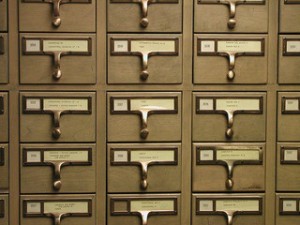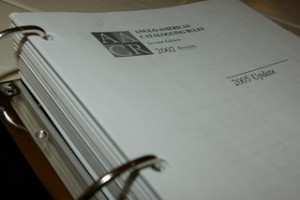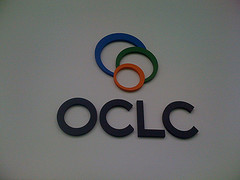 Ever wonder what happens behind the scenes to make library materials accessible to the public (that’s you!)? After books are selected and ordered, Cataloging staff work their magic to let you know what we’ve got. The word cataloging itself conjures images of card catalogs, book carts, and Dewey Decimal numbers, and while both of those are still in use to some extent, the majority of what cataloging means these days involves creating electronic access to metadata that describes both physical materials as well as digitized and born-digital materials that a library either leases or owns.
Ever wonder what happens behind the scenes to make library materials accessible to the public (that’s you!)? After books are selected and ordered, Cataloging staff work their magic to let you know what we’ve got. The word cataloging itself conjures images of card catalogs, book carts, and Dewey Decimal numbers, and while both of those are still in use to some extent, the majority of what cataloging means these days involves creating electronic access to metadata that describes both physical materials as well as digitized and born-digital materials that a library either leases or owns.
 Phew, that was a mouthful! What does all that actually mean, you ask? Cataloging, at its core, is about creating machine readable catalog records (known as MARC records), according to a set of rules; for many years these rules were the Anglo-American Cataloging Rules (2nd edition). However, a new set of rules has just recently been implemented….more on this below! These records describe books, movies, sound recordings, journals, manuscripts, and archival collections. A MARC record contains a lot of information that you would assume should be there (things like title, author, publication information, how many pages/volumes are present, subject, etc.) MARC records form the backbone of our public interface, Catalyst. Catalyst pulls the information from the MARC records in our database and displays that information to the public in a way that allows the public to search and discover the materials that they need.
Phew, that was a mouthful! What does all that actually mean, you ask? Cataloging, at its core, is about creating machine readable catalog records (known as MARC records), according to a set of rules; for many years these rules were the Anglo-American Cataloging Rules (2nd edition). However, a new set of rules has just recently been implemented….more on this below! These records describe books, movies, sound recordings, journals, manuscripts, and archival collections. A MARC record contains a lot of information that you would assume should be there (things like title, author, publication information, how many pages/volumes are present, subject, etc.) MARC records form the backbone of our public interface, Catalyst. Catalyst pulls the information from the MARC records in our database and displays that information to the public in a way that allows the public to search and discover the materials that they need.
 Where do those MARC records come from, you ask? Well, cataloging can be broken down into two main divisions: copy cataloging and original cataloging. OCLC, the Online Computer Library Center, maintains the largest database of MARC records in the world. These records have been created by librarians from decades ago up through today (librarians have always been great at sharing!). When we acquire a new book, OCLC’s database is searched to discover if a record for that book has already been created. If so, then we use that record. That’s known as copy cataloging (cataloging from copy that already exists). If a record does not exist, then we create one within OCLC’s database so that any other OCLC member library can use that record, and then download the record into our local database. This is known as original cataloging.
Where do those MARC records come from, you ask? Well, cataloging can be broken down into two main divisions: copy cataloging and original cataloging. OCLC, the Online Computer Library Center, maintains the largest database of MARC records in the world. These records have been created by librarians from decades ago up through today (librarians have always been great at sharing!). When we acquire a new book, OCLC’s database is searched to discover if a record for that book has already been created. If so, then we use that record. That’s known as copy cataloging (cataloging from copy that already exists). If a record does not exist, then we create one within OCLC’s database so that any other OCLC member library can use that record, and then download the record into our local database. This is known as original cataloging.
Now, all this sounds like a manual, labor intensive process, and while cataloging is complex, thanks to the monumental efforts of our Technical Services department, the vast majority of this process has been automated. With the assistance of a number of different services we are able to import bulk records for the materials that we acquire.
What does the future hold for cataloging? Right now is one of the most exciting times to be a cataloging librarian. The rules we currently use to catalog were originally created in 1967, with the second edition published in 1978. While these rules have been updated throughout the years, no significant changes have taken place. That is until now. Starting in April 2013, the US national libraries and the Sheridan Libraries, along with many other libraries throughout the country (and around the world) switched to a new cataloging code, known as RDA (Resource Description and Access). This new code has been crafted to be more flexible, more adaptable to changing data architecture, and more user-friendly (gone are the Latin abbreviations!). Stay tuned for more as the cataloging world turns…
